Are you considering giving your garage floor a fresh coat of paint to freshen up its appearance and protect it from stains and damage?
While painting might seem like an easy, cost-effective solution, there are several things to consider before diving in.
This article will examine the pros and cons of painting your garage floor. Then, we’ll look at some alternative solutions that are much more durable without breaking the bank.
First, let’s discuss why you might want to paint your garage floor…and when you shouldn’t.
Why You Might Want to Paint Your Garage Floor
There’s something deeply satisfying about walking into a beautifully finished garage, and the floor plays a huge role in that.
Painting your garage floor brightens up the appearance while providing a protective layer against the wear and tear of vehicles, tools, and foot traffic.
And, if you don’t have concrete floors, painted tile floors are a great way to quickly freshen up the room!
When painting your garage floor, the options are only limited by your imagination. Whether it’s a bold geometric design or a subtle motif, using stencils or painter’s tape allows you to create captivating patterns that reflect your style.
Adding flakes or chips into the paint can provide a textured, speckled effect. This enhances the look and adds some grip to the floor, which can be helpful in the garage.
Besides improving the looks, there are several practical reasons why homeowners choose to paint their garage floors:
- Affordability: Painting your garage floor is a fantastic option if you’re on a budget but still want to improve its look and feel. At just $0.15 to $0.30 per square foot, it’s an affordable way to refresh a space that often gets overlooked.
- Easy Application: You don’t need to be a professional to paint your garage floor. All it takes to give your floor a complete makeover is a standard paint roller or sprayer and a weekend afternoon. No specialized equipment is needed.
- Quick Drying Time: Time is of the essence for most DIYers, and, luckily, garage floor paint dries relatively quickly. In just a few hours, you’ll have a floor that’s ready to take on whatever you throw at it or park on it.
- Customization: Paints are easy to tint to any color you can imagine. You can match the aesthetic of your home or create a unique style all its own.
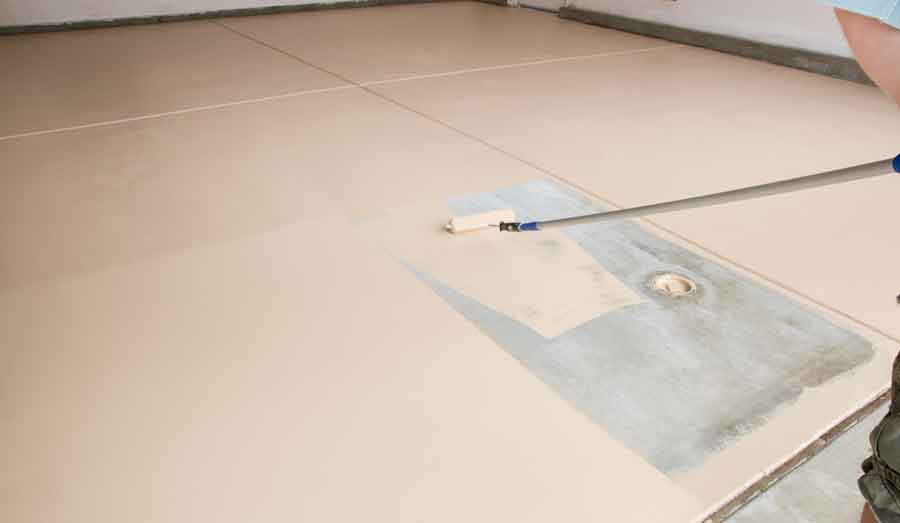
Why You Should Avoid Painting Your Garage Floor
While painting your garage floor offers many advantages, there are some drawbacks and limitations as well.
Here are some of them:
Adhesion Challenges: Concrete is naturally porous, making it tricky for paint to bond to it. The paint may not adhere correctly if you don’t meticulously clean and prepare your concrete slab. This may result in peeling or flaking down the road.
Durability Concerns: Garage floors are exposed to a lot, from everyday vehicle traffic to sudden temperature changes. This ever-changing environment makes it common for painted garage floors to chip or peel due to temperature fluctuations, moisture, and even regular traffic. Of course, dropping tools or moving heavy machinery can also cause the paint to chip or scratch.
Fading & Staining: While a freshly painted garage floor looks fantastic, it’s vulnerable to life’s messes. Exposure to sunlight can cause the paint to fade over time. Spilled dirt, oil, grease, or chemicals can leave stubborn stains, dulling your floor’s once-spotless appearance.
Water Penetration: Garage floor paint will not act as a reliable sealant. Painted garage floors are still susceptible to water damage that a coated garage floor wouldn’t be. Over time, moisture accumulation can lead to concrete cracking or spalling, where bits of the surface start to flake or chip away. Trapped moisture also encourages mold growth, a problem no homeowner wants to tackle.
While painting your garage floor has undeniable aesthetic and practical benefits, the potential challenges warrant consideration. Other garage flooring options offer increased durability or protection, which could be a smart move.
If you still want to go the painting route, choosing the right paint will go a long way to making your garage floor more durable.
Let’s discuss that in the next section.
How to Choose the Best Garage Floor Paint
Choosing the right type of garage floor paint can feel like being a kid in a candy store. There are too many options, and you’re not sure where to start.
Concrete and paint have a complex relationship.
Choose the wrong garage floor paints, and you might end up with a peeling, fading mess.
But when paired correctly, it’s a perfect blend that enhances your garage floor’s appearance, durability, and protection.
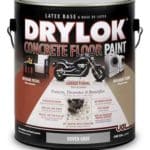
Latex Paint: Latex is a water-based paint known for its easy application and cleanup. It’s not the end of the world if you accidentally spill some. A little soap and water are all you need to tidy up.
Another plus is its rapid drying time, making it perfect for those weekend projects. Low odor and VOCs make it the go-to choice for those sensitive to the strong scents often associated with paint. It’s also one of the most budget-friendly options while still offering a vast array of color options.
There are some trade-offs. Latex might struggle with the everyday demands of a bustling garage, especially when exposed to moisture, chemicals, and general wear and tear. This paint can peel or crack if the concrete floor isn’t adequately prepared. It can also fade or stain when subjected to sunlight and dirt.

Acrylic Paint: Think of acrylic garage floor paint as a better version of latex paint. It includes additional additives to improve durability. It’s still easy to apply and offers low odor and VOCs to make painting more pleasant.
While acrylic paint is more durable than latex, it’s still not very good against moisture, chemicals, and abrasion. It’s also more expensive than regular latex paint.
Oil-based Paint: This solvent-based paint promises a hard, glossy finish resilient against moisture, chemicals, and abrasion. Its superior adhesion means fewer chances of peeling or cracking.
Unfortunately, this also complicates application and cleanup, often requiring solvents. The strong odor and high VOCs mean ventilation is a top priority during the long drying times. And although it offers a durable finish, it’s more expensive than both latex and acrylic paints.
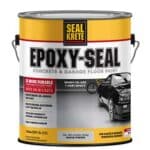
Epoxy Paint: Epoxy paint is different than epoxy coatings, which we’ll discuss briefly in a later section. Epoxy paint is a latex acrylic product with a hint of epoxy resin. It’s easy to apply using rollers or brushes and dries quickly.
However, it doesn’t protect as well as other floor coatings. Over time, you might notice wear, stains, or even flaking. It’s best suited for areas with light traffic, such as residential garages not subjected to heavy-duty activities.
Tips for Choosing the Best Paint for Your Garage
When choosing the best garage floor paint, there are several things to consider:
- Condition of your concrete slab: With latex and acrylic, you can be more lenient in prep, though longevity might be compromised. Oil-based and epoxy paints demand thorough preparation. They adhere better to drier, cleaner, and rougher concrete floors.
- Climate & exposure to sunlight: Latex and acrylic do not do well in direct sunlight or extreme environments. Oil-based and epoxy, however, are more resilient, tackling varying temperatures with grace.
- Garage Traffic: Consider the kind of traffic you have in your garage. Lighter-duty garages do fine with latex or acrylic. Heavy-traffic areas will require the higher durability of oil-based or epoxy paints.
- Color & Finish Options: Dreaming of a garage in a specific shade or finish? Latex and acrylic offer a broad palette, while oil-based and epoxy are limited in color customization.
- Budget & availability: On a budget? Latex and acrylic paints are easily found online and offline and won’t strain your finances. Oil-based and epoxy are more expensive and may require more effort to find.
Choosing the correct type of garage floor paint now can save you from frequent repaints and touch-ups down the line.
What Are Some Better Alternatives to Painting Your Garage Floor?
While painting your garage floor might seem quick and cost-effective, we’ve seen how it’s not the best solution for longevity and durability.
The best garage floor coatings will provide superior performance, durability, and aesthetic appeal compared to traditional paints. Here are a few of my favorites:
Epoxy Coating
Epoxy coatings comprise a two-part resin system that hardens into a glossy and sturdy finish, forming a powerful bond with concrete surfaces. Beyond its impressive adhesion properties, epoxy is great against moisture, chemicals, stains, impacts, and abrasions. It also offers a wide variety of color options, including adding flakes or chips for an enhanced texture and style.
An epoxy garage floor coating generally costs between $3 to $12 per square foot, depending on its quality and desired thickness, referred to as its solids content.
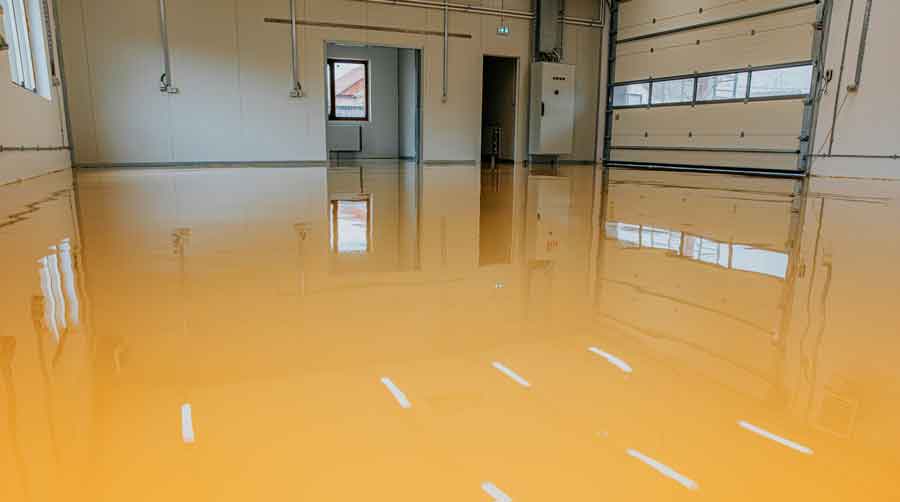
Polyurea Coating
Polyurea is an elastomer that cures into a flexible yet robust finish.
This coating adheres well to concrete garage floors, resisting challenges like moisture, chemicals, UV rays, drastic temperature changes, and the wear and tear of daily activities. Aesthetically, polyurea delivers with its high gloss and clarity, uplifting the floor’s overall look.
In terms of expenditure, polyurea usually ranges from $5 to $15 per square foot, depending on the thickness and quality.
Polyaspartic Coating
Polyaspartic is a fast-curing derivative of polyurea. This coating shares the best properties of polyurea, such as durability and resistance, but offers some distinct advantages. Its rapid curing time means garage owners can achieve a fresh, protective layer in a shorter time. Polyaspartic is also effective across a broader spectrum of temperatures and humidity levels.
Typically, the cost for polyaspartic coatings lies between $6 to $18 per square foot, based on its quality and thickness.
Any of these garage floor coatings will improve protection while being an aesthetic upgrade to your garage floor. You can achieve a smooth surface that conceals the imperfections and cracks in the concrete.
Most are available in a wide range of colors, finishes, and textures, from solid shades to metallic hues.
Finally, these coatings offer long-term value. Garage floors treated with epoxy, polyurea, or polyaspartic coatings resist common issues like fading, peeling, or chipping. Maintenance is easy. Routine cleaning with a mild detergent and mop keeps the floor looking as good as new.
TLDR: Moving beyond traditional paints might be your best option if you want a long-lasting, visually appealing solution for your garage floors.
How to Paint Garage Floors
Painting a garage floor offers many advantages, not just from an aesthetic standpoint but also in terms of durability and overall protection.
When done correctly, a freshly painted floor will significantly improve your garage’s appearance, enhance the concrete’s durability, and protect it from damages caused by oil spills, dirt accumulation, moisture infiltration, and general wear and tear.
Painting your garage floor will also make it easier to maintain and may help cover up small cracks, scratches, or hot tire pickup.
Step 1: Preparing the Garage Floor
Start your painting process by preparing the floor. This involves emptying your garage, including furniture, equipment, vehicles, and other miscellaneous items.
Next, give the floor a thorough cleaning.
Sweep away loose debris, vacuum to pick up dust, and, if available, use a pressure washer for a deep cleanse. A potent concrete degreaser or a bleach solution can be beneficial for any tough stains, especially grease.
Step 2: Repair Cracks & Holes
Before you bring out the paint cans, ensure the floor is in good condition. This means addressing any cracks, holes, or other imperfections on the concrete surface.
Using concrete fillers or patches can help seal these gaps. Consider grinding the surface or employing an etching solution for a smoother finish to facilitate better paint adhesion.
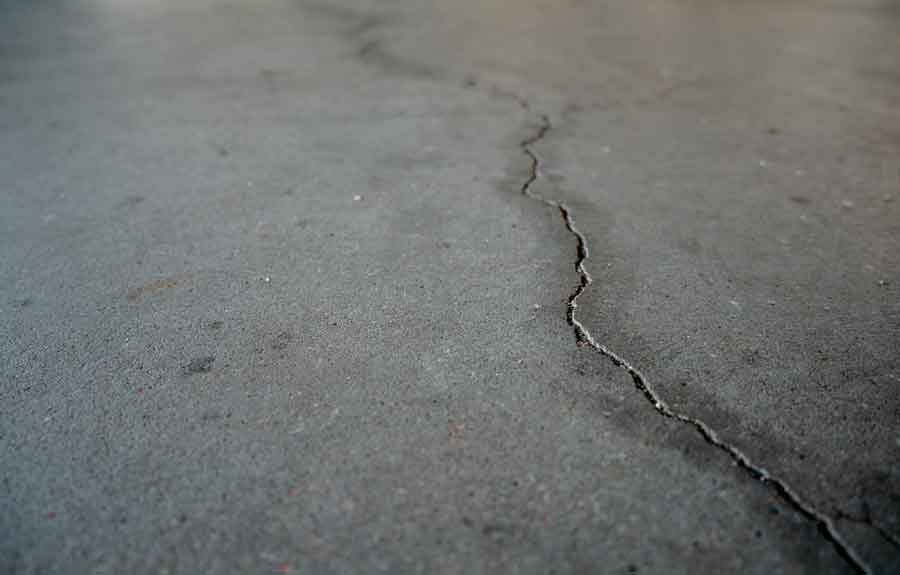
Step 3: Start with a Concrete Primer
Primers aren’t just for walls. It’s a crucial step for painting garage floors, too.
A primer will enhance the paint’s ability to bond with the concrete, ensuring a more durable result.
Spread the primer evenly across the floor using a long-handled roller or sprayer. A brush can come in handy for corners or edges where a roller may not reach.
Once the entire floor is primed, allow it to dry thoroughly before proceeding.
Step 4: Painting the Floor
This step will change slightly depending on your choice of paint.
Whether you opt for latex, acrylic, oil-based, or epoxy paint, ensure to read the manufacturer’s instructions.
Applying the paint using a long-handled roller or sprayer, ensuring each coat dries fully before applying the next.
Step 5: Adding Finishing Touches
Once your floor is painted, consider any finishing touches you might want.
For example, you could integrate anti-slip additives to prevent slips and falls. Decorative flakes can also be sprinkled in for an extra dash of style.
Alternatively, a clear concrete sealer or topcoat might be the finishing touch you’re looking for to improve durability and moisture resistance.
Step 6: Curing the Paint
Your freshly painted garage floor will need time to cure. The exact time will vary based on the type of paint used and climate. It typically ranges anywhere from a few hours to several days.
Avoid walking, driving, or placing heavy objects on the floor during this period.
Pro Tips
To achieve the best results with minimal hassle, here are some things to keep in mind:
- Plan for a day with mild weather and low humidity to paint. This facilitates better drying and curing of the paint.
- Prioritize safety. Wear gloves, goggles, a mask, and old clothes to protect yourself, especially if the paint has potent fumes.
- Ensure good ventilation in the garage. Open windows and doors, or use fans if required.
- After painting your garage floor, clean your tools per the manufacturer’s recommendations.
- Lastly, store any unused paint responsibly. Keep it away from the reach of children and pets. Empty paint cans should be disposed of according to local regulations.
Wrapping It Up
As homeowners, we need to refresh our garage floors every so often. Most of us think about painting our garage floors at some point, deciding that easy application is more important than durability.
As we’ve seen, while painting your garage floor might initially seem like the easiest solution, it comes with challenges.
The wrong or poorly applied paint can be susceptible to peeling, chipping, and staining. It doesn’t do well with concrete’s porous nature and could leave your floor vulnerable to moisture and chemical damage.
If you’re still leaning towards painting your garage floor, it’s crucial to select the correct type of paint.
Latex and acrylic paints, though readily available and affordable, may not offer the durability many garages need. Oil-based paints are an improvement. However, epoxy-based paints bridge the gap between paint and more robust coatings.
If longevity and resilience are what you want, alternatives like pure epoxy, polyurea, and polyaspartic coatings might be worth considering. They provide a higher degree of protection against common garage threats and can sustain the wear and tear of everyday activities better than traditional paints.
So, should you paint a garage floor?
Painting can be a suitable option if you’re seeking a quick, budget-friendly facelift. But if you prefer a long-term, more durable solution, I recommend exploring more robust garage floor coatings.
Check out this article, where I rank 11 major garage floor coatings in terms of durability, price, ease of application, and more!
